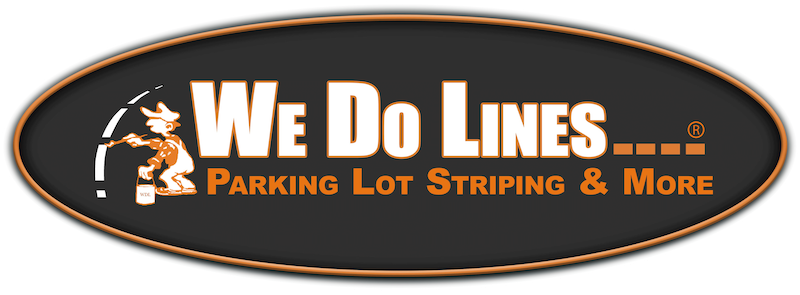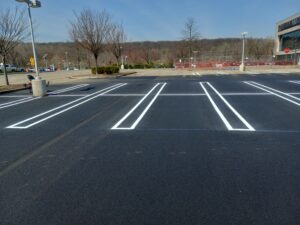Parking lot striping may seem like a mundane task, but it plays a vital role in ensuring the safety and efficiency of parking areas. Beyond its functional aspects, We Do Lines believes parking lot striping is also an art form that involves careful planning, precise execution, and a keen understanding of marking styles and colors. There are numerous variables that are important when it comes to parking lot striping, and we can discover these while examining various marking styles, colors, and meanings.
Marking Styles – Guiding Those Drivers!
When it comes to parking lot striping, various marking styles are employed to guide drivers effectively and optimize parking space utilization. These styles and markings give information to drivers needed to make safe and cautious decisions as they navigate the lot. These are some of the commonly used marking styles:
- Perpendicular Markings:
- Perpendicular markings are the most common style, with lines running perpendicular to the parking space. These lines guide drivers and indicate where to park their vehicles. They are often used in parking lots where vehicles park side by side.
- Parallel Markings:
- Parallel markings are used in parking lots where vehicles park parallel to each other, such as in angled or diagonal parking spaces. These lines indicate the boundaries of each parking space, ensuring vehicles are parked parallel and maintaining an organized parking layout.
- Diagonal Markings:
- Diagonal markings are often seen in larger parking lots and are designed to maximize space utilization. These lines create a diagonal orientation for parking spaces, allowing for more efficient parking. Diagonal markings can also aid in improving traffic flow and reducing congestion.
- Center Lines:
- Center lines are used to separate traffic flow in parking lots and provide guidance to drivers. They divide lanes and help drivers navigate the parking area safely. Center lines are particularly important in larger parking lots with multiple lanes to ensure a smooth and organized flow of vehicles.

Colors That Speak And Communicate
In addition to marking styles, colors are another crucial aspect of parking lot striping. Colors are used to convey information and communicate specific meanings to drivers. Here are some common colors used in parking lot striping and their corresponding meanings:
- Yellow:
- Yellow is one of the most commonly used colors in parking lot striping. It signifies caution and is typically used for markings such as lines, arrows, and cross-hatching. Yellow markings are often found in areas where drivers need to exercise caution, such as near pedestrian crossings or areas with potential hazards.
- White:
- White is widely used for standard parking space markings, including lines and symbols. It indicates that the area is designated for parking and helps drivers identify the boundaries of individual parking spaces. This might be one of the colors you immediately think of when you think “parking lot.”
- Blue:
- Blue is typically used to designate parking spaces reserved for people with disabilities and ADA compliance. These spaces are wider and marked with the international symbol of accessibility. Blue markings serve as a visual indicator to drivers that these spaces are specifically designated for individuals with disabilities and should be located near the front of buildings to allow ease of access for those who are disabled. The wider dimensions of these spots allow for wheelchair-bound individuals to safely exit.
- Red:
- Red is commonly used for fire lanes and emergency zones. These areas must be kept clear at all times to ensure easy access for emergency vehicles. Red markings help drivers identify these zones and discourage unauthorized parking, ensuring the safety of the premises. In other words: if you’re not an emergency vehicle, DON’T PARK!
- Green:
- Green is occasionally used to mark areas such as loading zones or time-limited parking spots. These spaces are often reserved for specific purposes, such as loading and unloading goods or short-term parking. Green markings help drivers differentiate these areas from regular parking spaces and are often found in front of establishments to allow ease of loading.
Parking lot striping is not just about the functional organization and safety of visitors; it is an art that requires careful consideration of marking styles and colors. Colored and striped parking lots provide a professional and clean look that otherwise wouldn’t exist. By employing various marking styles, parking lot striping guides drivers efficiently and optimizes space utilization. Additionally, the strategic use of colors communicates important information to drivers, enhancing safety and accessibility. Keep your parking lots safe AND pretty with considerate parking lot striping!




